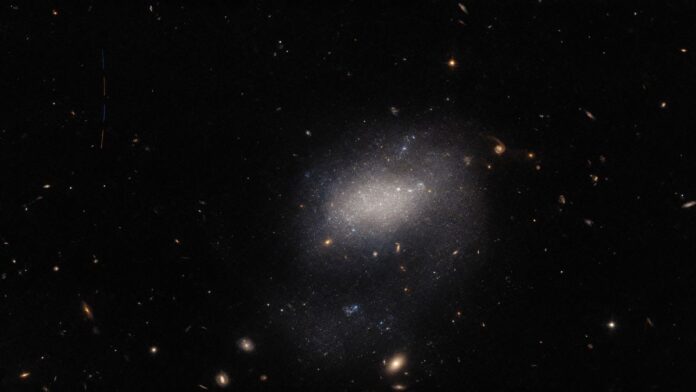The Hubble Space Telescope caught an unexpected asteroid streaking across a field of distant galaxies.
In the image, released on Monday (Jan. 16) by the European Space Agency (ESA), the asteroid can be seen as a row of four thin consecutive lines captured in alternating shades of blue and orange spreading from the left upper corner toward the middle section of the image.
The asteroid, ESA said in a statement (opens in new tab), is only a few kilometers (miles) wide, and part of our solar system. The other objects seen in the image, however, are far more distant. The Hubble Space Telescope took the image as part of a campaign focused on observing all of the nearest galactic neighbors of our galaxy, the Milky Way.
Related: The best Hubble Space Telescope images of all time!
When the project was proposed, only 75% of the Milky Way’s galactic neighbors had their picture taken by Hubble, ESA said in the statement. To capture the remaining 25%, astronomers used gaps between longer observation campaigns in the telescope’s schedule.
“The project was an elegantly efficient way to fill out some gaps not only in Hubble’s observing schedule, but also in our knowledge of nearby galaxies,” ESA said in the statement.
The asteroid in the image appears as four separate streaks because the image consists of four exposures. Each line has a different color due to the filters used by Hubble’s Advanced Camera for Surveys, which took the photographs.
Dominating the image is a small galaxy known as UGC 7938. Located some 30 million light-years from Earth in the constellation Virgo, UGC 7938 appears as a grainy, fuzzy cloud at the center of the image. The dwarf galaxy, characteristic for its irregularity, is a primitive type that astronomers believe was common in the early universe when galaxies started to form.
All over the image, tens of background galaxies are scattered ranging from evolved spirals to simple ellipticals that have not yet developed a more intricate internal structure. The simple orange and white specks of light dotting the image are stars inside our galaxy, the Milky Way.
Follow Tereza Pultarova on Twitter @TerezaPultarova. Follow us on Twitter @Spacedotcom and on Facebook.

